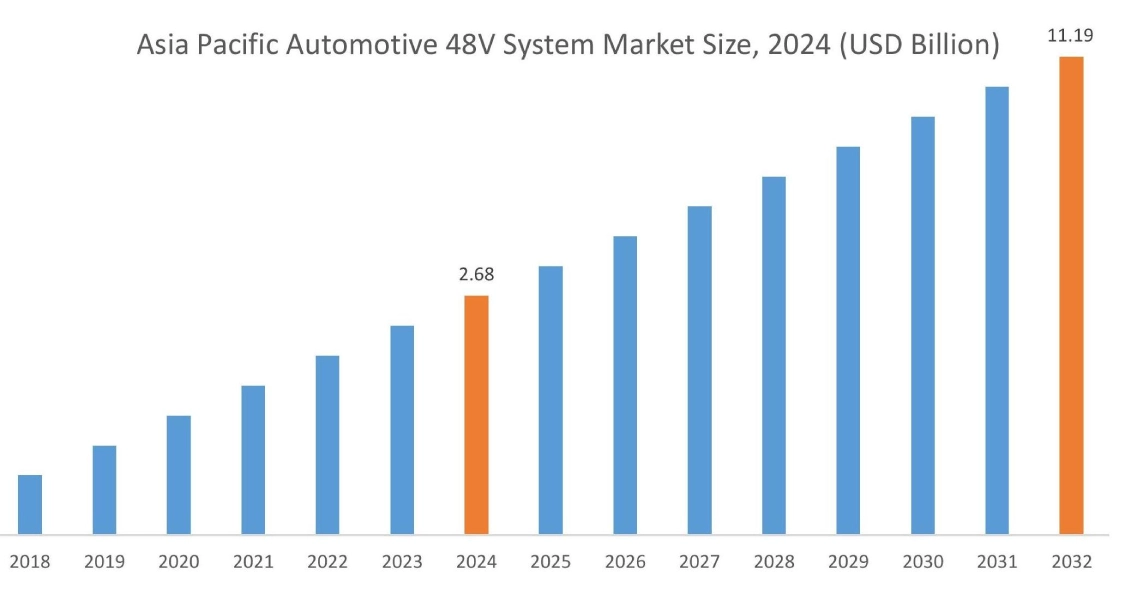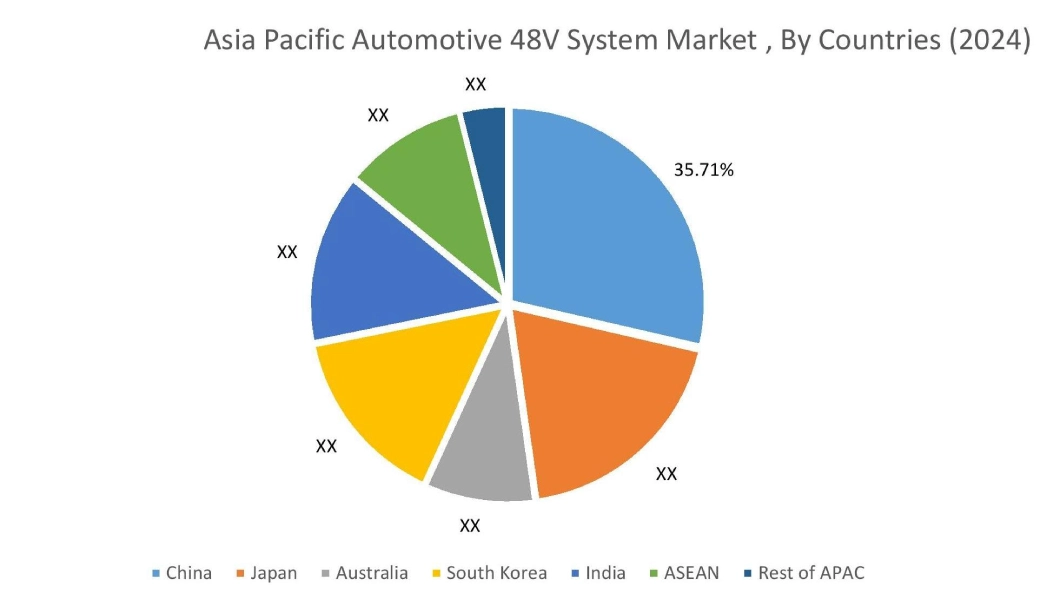Automotive 48V System Market Size:
Automotive 48V System Market size is estimated to reach over USD 34.25 Billion by 2032 from a value of USD 8.42 Billion in 2024 and is projected to grow by USD 9.88 Billion in 2025, growing at a CAGR of 21.5% from 2025 to 2032.
Automotive 48V System Market Scope & Overview:
Automotive 48V system refers to an electrical system that uses 48 volts of electricity for powering automotive electronic components. The systems in automobiles allow the same power delivery with reduced current due to the high voltage compared to a 12V system. Additionally, these electrical systems enable evolved features, including electric turbocharging and regenerative braking, among others, which are driving its use in automobiles. Moreover, switching to a 48V electrical system from 12V reduces the current levels the vehicle's wiring requires, which can enable the utilization of lighter and smaller gauge wires that cost less, which is driving the market.
How is AI Impacting the Automotive 48V System Market?
AI is driving significant advancements in the automotive 48V system market by improving efficiency, safety, and energy management. These systems are critical for hybrid vehicles, and AI optimizes how power is distributed between the battery, motor, and auxiliary systems to maximize fuel savings and performance. Through predictive analytics, AI monitors driving patterns and adjusts energy use in real time, enhancing overall efficiency. It also supports predictive maintenance by detecting potential faults in batteries or converters before they impact performance. In addition, AI enables seamless integration with advanced driver assistance systems (ADAS) and electric components, making vehicles safer and more reliable. As electrification accelerates, AI is becoming central to the evolution of 48V systems globally.
Automotive 48V System Market Dynamics - (DRO) :
Key Drivers:
Rising Number of Regulations to Improve Fuel Efficiency is Propelling the Automotive 48V System Market Growth
Governments around the world are increasingly focusing on regulating fuel consumption in vehicles to improve fuel efficiency and reduce CO2 emissions. 48V systems in hybrid vehicles can offer an electric range of up to 80 km, which can drastically reduce CO2 emissions. Moreover, automobile 48V systems can help manufacturers achieve fuel consumption targets and comply with regulations by allowing a greater electric range in hybrid cars.
- For instance, in June 2024, the US National Highway Traffic Safety Administration announced new fuel economy standards with the aim of reducing pollution. The new rules aim to increase the fuel economy of light-duty vehicles up to approximately 50.4 miles per gallon by model year 2023.
Hence, the rising adoption of 48V systems in automobiles due to improved fuel efficiency is driving the automotive 48V system market size.

Key Restraints :
High Initial Upfront Investment Cost is Restraining the Automotive 48V System Market Growth
An automobile 48V system often involves various components, including power converters, wiring harnesses, and control systems. The implementation of these components requires a high upfront investment by both the manufacturers and end consumers. Further, in electric vehicles with a 48V system, the components and charging systems need to be compatible with both 48V and higher-voltage battery packs, which requires coordination between low and high voltage systems, acting as a restraint.
Thus, high initial upfront investment costs due to the costs of converters, wiring harnesses, and control systems as a restraint to the automotive 48V system market expansion.
Future Opportunities :
Rising Adoption of 48V System in Commercial Vehicles is Expected to Drive the Automotive 48V System Market Opportunities
Automotive 48V system is increasingly used in commercial vehicles due to its increased power density and improved energy efficiency. Further, 48V systems allow for efficient start-stop, allowing the commercial vehicle to shut off when it comes to a stop, which can save fuel.
- For instance,Eaton offers a 48V mild hybrid system that features a 48V motor that connects to the PTO opening. The regenerative system can be used to power components when the engine is off, which can help in reducing emissions.
Thus, the rising technological advancements associated with 48V systems in commercial vehicles due to energy savings and powering accessories in the vehicle is projected to drive the automotive 48V system market opportunities during the forecast period.
Automotive 48V System Market Segmental Analysis :
By Architecture:
Based on architecture, the market is segmented into dual clutch, belt mounted, crankshaft-mounted, and transmission mounted.
Trends in the architecture:
- Increasing adoption of belt mounted architecture with an exciter winding is driving the automotive 48V system market share.
- Rising utilization of crankshaft-mounted architecture for high torque transmission is driving the automotive 48V system market trends.
Belt mounted accounted for the largest revenue share of 47.89% in the year 2024.
- Belt mounted architecture offers cost-effective integration in P0 powertrainconfigurations, which is driving the market.
- Additionally, increasing adoption of belt mounted starter generators that feature hybrid cooling, using air or mixed air/water cooling methods has driven the market.
- Moreover, manufacturers have started offering belt mounted starter generators that feature high RPM and high mechanical power.
- For instance, Valeo offers a 48V belt starter generator (iBSG) that offers peak mechanical power of up to 10 kWp and continuous power at 6000 RPM.
- According to the market analysis, the rising advancements related to belt mounted due to hybrid cooling, high mechanical power, and high RPM are driving the automotive 48V system market trends.
Crankshaft-mounted is anticipated to register the fastest CAGR during the forecast period.
- In crankshaft-mounted, the electric motor rotor is connected directly to the crankshaft allowing the driving force of the electric motor to be directly transmitted.
- Further, manufacturers of hybrid/electric vehicles have started integrating crankshaft-mounted architecture due to shorter response time of the torque.
- For instance, Infineon offers solutions for crankshaft-mounted integrated starter generator in P1 configuration featuring higher torque power and efficient space usage.
- Thus, the rising trend in the utilization of crankshaft-mounted due to higher torque and shorter response time of the torque is propelling the automotive 48V system market demand during the forecast period.

By Vehicle:
Based on the vehicle, the market is segmented into ICE vehicles and Electric Vehicles (EVs)
Trends in the vehicle:
- Rising trend towards adoption of 48V system in hybrid vehicle equipped with an internal combustion engine to boost engine performance is driving the global automotive 48V system market.
- Increasing utilization of 48V system for improved power distribution has resulted in the growth of the market.
ICE vehicles accounted for the largest revenue share in the year 2024.
- Mild hybrid vehicles have experienced a rising adoption of 48V system to supply the vehicle’s electrical system and lighten the engine’s workload.
- Additionally, 48V batteries have experienced rising advancements in the cooling methods by integrating passive cooling to increase their heat tolerance.
- Moreover, manufacturers have started offering 48V batteries that are compact and can be stored in the trunk of the ICE vehicles.
- For instance,Bosch offers a 48-volt battery that is only 90 millimeters high and can be stored in the car’s trunk or under the passenger seat.
- According to the analysis, increasing utilization of 48V system due to integration of passive cooling and compact size of the batteries is driving the automotive 48V system market expansion.
Electric vehicles (EVs) is anticipated to register the fastest CAGR during the forecast period.
- 48V system in electric vehicles offer four times the power of 12V, which enables the powering of HVAC without draining the battery.
- Moreover, manufacturers of electric vehicles have started integrating 48V system due to thinner wiring, which reduces the overall weight of the electric vehicles.
- For instance, Tesla in its Cybertruck utilizes a 48V system to power the windows, doors, and touchscreen.
- According to the market analysis, the increasing adoption of 48V system in electric vehicles due to thinner wiring and lower draining of the battery is anticipated to boost the overall market trends during the forecast period.
By Applications:
Based on the applications, the market is segmented into auxiliary systems, braking, ADAS, air conditioning, active suspension, and others.
Trends in the applications:
- Increasing adoption of automotive 48V system in braking for precise vehicle handling and reliable braking is driving the market.
- Rising adoption of automotive 48V system in ADAS for powering sensors and actuators is driving the market growth.
Braking accounted for the largest revenue share in the year 2024.
- 48V braking systems, particularly with regenerative braking, are utilized to convert kinetic energy into electrical energy during braking and store it in a 48V battery.
- Electric vehicles are increasingly integrating electric braking that uses 48V architecture to offer a stable supply of power and quick responsiveness.
- Additionally, the growing need for car manufacturers to improve fuel efficiency by utilizing the energy recovered from braking in vehicles with combustion engines is driving the market.
- For instance, Audi for its Q8 mild hybrid model utilizes a 48V electrical subsystem through the use of a lithium ion battery and a belt alternator starter. The vehicle can recover up to 12kW of power during braking and feed the power back into the battery.
- Therefore, the increasing demand for 48V system in braking due to stable supply of power and conversion of energy is driving the automotive 48V system market size.
ADAS is anticipated to register the fastest CAGR during the forecast period.
- ADAS uses 48V systems to efficiently power control units that are used for processing sensor data.
- Moreover, companies have started integrating 48V system to reduce energy loss and enable precise control of the electrical systems for powering ADAS features, including adaptive cruise control and lane keeping.
- For instance, Molex offers the MX150 connector series to handle the specifications of 48V applications, which includes powering the vehicle’s ADAS system.
- According to the automotive 48V system market analysis, the growth in 48V system to power the sensors, actuators, and control units in ADAS is propelling the automotive 48V system industry during the forecast period.
Regional Analysis:
The regions covered are North America, Europe, Asia Pacific, the Middle East and Africa, and Latin America.

Asia Pacific region was valued at 2.68 Billion in 2024. Moreover, it is projected to grow by 3.16 Billion in 2025 and reach over 11.19 Billion by 2032. Out of this, China accounted for the maximum revenue share of 35.71%. As per the automotive 48V system market analysis, the growth in the Asia-Pacific region is primarily driven by the rising adoption of 48V systems for use in mild hybrid vehicles and the rising ownership of passenger vehicles .
- For instance, Tata Motors registered annual sales of 5,73,541 units of passenger and electric vehicles in 2023, which is up 6% compared to FY23. The growing sales of passenger cars, especially hybrid cars, is expected to boost the automotive 48V system market.

North America is estimated to reach over USD 9.45 Billion by 2032 from a value of USD 2.29 Billion in 2024 and is projected to grow by USD 2.69 Billion in 2025. In North America, the growth of the automotive 48V system industry is driven by the growing investments in the 48V system for use in air conditioning in vehicles. Moreover, the increasing adoption of 48V systems to power auxiliary systems has resulted in the rise of the automotive 48V system market share.
- For instance, ABLIC offers high-caliber integrated circuits for use in 48V mild hybrid electric vehicle auxiliary operations. The rising utilization of 48V systems for power auxiliary systems is expected to boost the overall market.
Additionally, the regional analysis depicts that the growing adoption of 48V batteries in electric vehicles is driving the automotive 48V system market demand in Europe. Furthermore, as per the market analysis, the market demand in Latin America is expected to grow at a considerable rate due to the rising adoption of 48V systems for active suspension in mild hybrid vehicles. Middle East and African regions are expected to grow at a considerable rate due to factors such as growing demand for 48V systems for utilization in braking and rising investments in R&D by vehicle manufacturers, among others.
Top Key Players & Market Share Insights:
The global automotive 48V system market is highly competitive with major players providing solutions to the national and international markets. Key players are adopting several strategies in research and development (R&D), product innovation, and end-user launches to hold a strong position in the automotive 48V system market. Key players in the automotive 48V system industry include-
- Bosch GmbH (Germany)
- Dalroad (U.K.)
- MTA S.p.A. (Italy)
- Texas Instruments Incorporated (U.S.)
- Eaton (Ireland)
- Valeo (France)
- SEG Automotive (Germany)
- Infineon Technologies AG (Germany)
- Vicor Corporation (U.S.)
- Caresoft Global Technologies, Inc. (U.S.)
Recent Industry Developments :
Product Launch
- In October 2024, Vicor launched three automotive power modules called the BCM6135, DCM3735, and PRM3735 that support 48V power distribution in vehicles. Moreover, the power modules can be utilized to increase the power levels and reduce in weight of the power system.
- In September 2024, Toyota announced the release of the Toyota Hilux Hybrid 48V, which features a 48V hybrid system. The 48V hybrid system utilizes a 48V lithium-ion battery with a 4.3Ah capacity and 13 cells, weighing only approximately 7.6 kg.
Automotive 48V System Market Report Insights :
| Report Attributes | Report Details |
| Study Timeline | 2019-2032 |
| Market Size in 2032 | USD 34.25 Billion |
| CAGR (2025-2032) | 21.5% |
| By Architecture |
|
| By Vehicle |
|
| By Applications |
|
| By Region |
|
| Key Players |
|
| North America | U.S. Canada Mexico |
| Europe | U.K. Germany France Spain Italy Russia Benelux Rest of Europe |
| APAC | China South Korea Japan India Australia ASEAN Rest of Asia-Pacific |
| Middle East and Africa | GCC Turkey South Africa Rest of MEA |
| LATAM | Brazil Argentina Chile Rest of LATAM |
| Report Coverage |
|
Key Questions Answered in the Report
How big is the automotive 48V system market? +
The automotive 48V system market is estimated to reach over USD 34.25 Billion by 2032 from a value of USD 8.42 Billion in 2024 and is projected to grow by USD 9.88 Billion in 2025, growing at a CAGR of 21.5% from 2025 to 2032.
Which is the fastest-growing region in the automotive 48V system market? +
Asia-Pacific region is experiencing the most rapid growth in the automotive 48V system market.
What specific segmentation details are covered in the automotive 48V system market report? +
The automotive 48V system market report includes architecture, vehicle, applications, and region.
Who are the major players in the automotive 48V system market? +
The key participants in the automotive 48V system market are Bosch GmbH (Germany), Valeo (France), SEG Automotive (Germany), Infineon Technologies AG (Germany), Vicor Corporation (U.S.), Caresoft Global Technologies, Inc. (U.S.), Dalroad (U.K.), MTA S.p.A. (Italy), Texas Instruments Incorporated (U.S.), Eaton (Ireland), and others.

